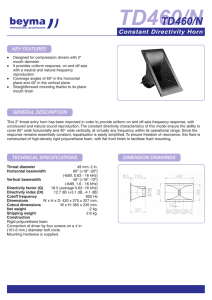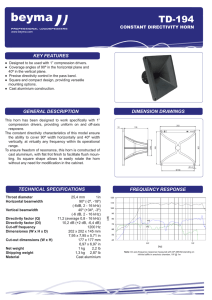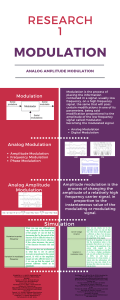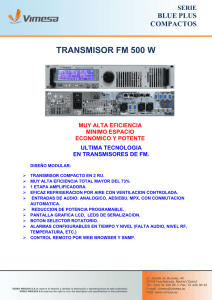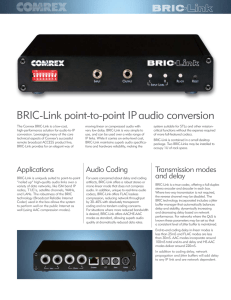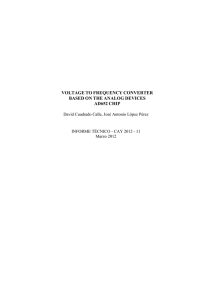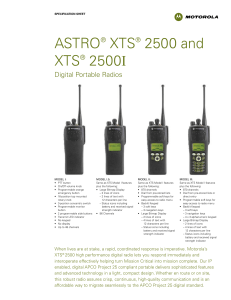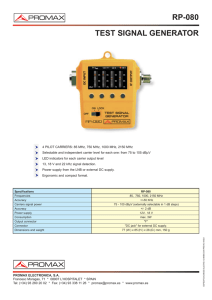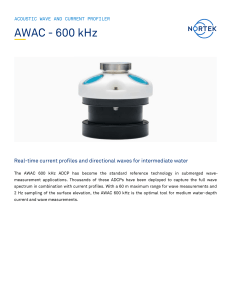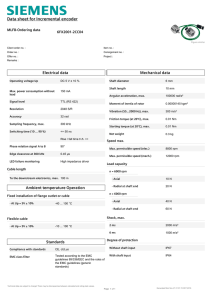Harris Corporation Broadcast Communications DIGIT-CD Digital FM Exciter
Anuncio
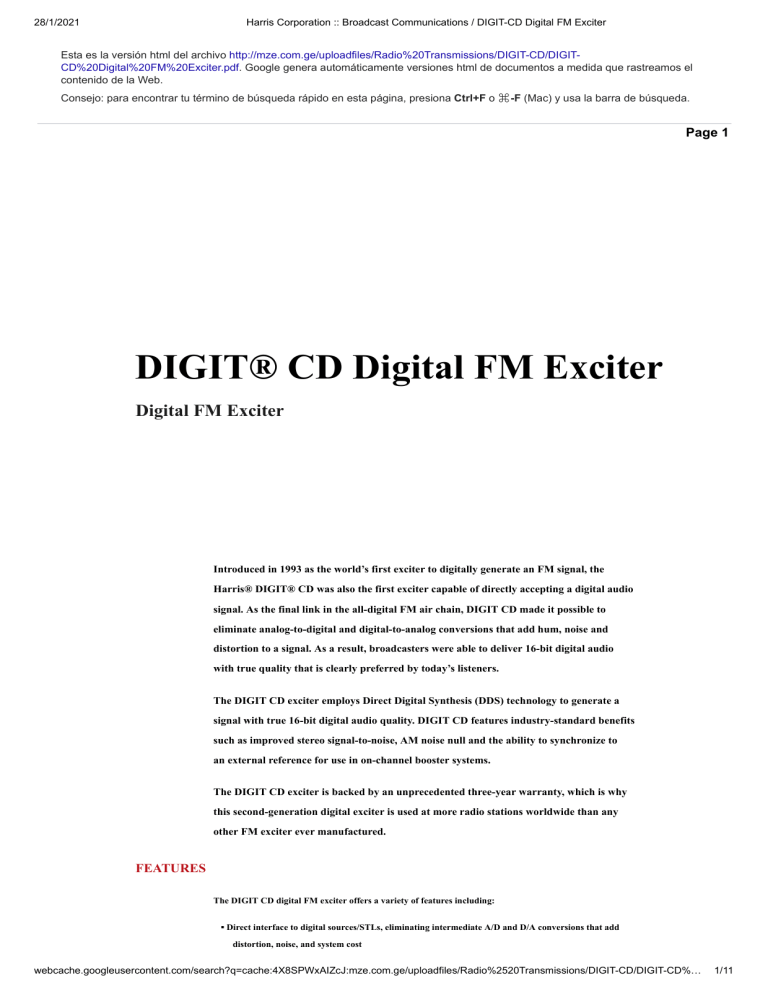
28/1/2021 Harris Corporation :: Broadcast Communications / DIGIT-CD Digital FM Exciter Esta es la versión html del archivo http://mze.com.ge/uploadfiles/Radio%20Transmissions/DIGIT-CD/DIGITCD%20Digital%20FM%20Exciter.pdf. Google genera automáticamente versiones html de documentos a medida que rastreamos el contenido de la Web. Consejo: para encontrar tu término de búsqueda rápido en esta página, presiona Ctrl+F o ⌘-F (Mac) y usa la barra de búsqueda. Page 1 DIGIT® CD Digital FM Exciter Digital FM Exciter Introduced in 1993 as the world’s first exciter to digitally generate an FM signal, the Harris® DIGIT® CD was also the first exciter capable of directly accepting a digital audio signal. As the final link in the all-digital FM air chain, DIGIT CD made it possible to eliminate analog-to-digital and digital-to-analog conversions that add hum, noise and distortion to a signal. As a result, broadcasters were able to deliver 16-bit digital audio with true quality that is clearly preferred by today’s listeners. The DIGIT CD exciter employs Direct Digital Synthesis (DDS) technology to generate a signal with true 16-bit digital audio quality. DIGIT CD features industry-standard benefits such as improved stereo signal-to-noise, AM noise null and the ability to synchronize to an external reference for use in on-channel booster systems. The DIGIT CD exciter is backed by an unprecedented three-year warranty, which is why this second-generation digital exciter is used at more radio stations worldwide than any other FM exciter ever manufactured. FEATURES The DIGIT CD digital FM exciter offers a variety of features including: ▪ Direct interface to digital sources/STLs, eliminating intermediate A/D and D/A conversions that add distortion, noise, and system cost webcache.googleusercontent.com/search?q=cache:4X8SPWxAIZcJ:mze.com.ge/uploadfiles/Radio%2520Transmissions/DIGIT-CD/DIGIT-CD%… 1/11 28/1/2021 Harris Corporation :: Broadcast Communications / DIGIT-CD Digital FM Exciter ▪ Digital Signal Processor (DSP) synthesis of stereo — providing perfect stereo, with none of the signal degradation resulting from the amplitude and phase limitations of analog baseband. ▪ Modulator frequency response to DC — providing performance unaffected by large transients in program sources (STL carrier squelch, etc.) and elimination of off-air time from AFC/PLL overload or relock ▪ Externally Controlled Carrier Frequency Synchronization — providing controlled and stable service with a minimum of interaction in the coverage areas of the main and booster transmitters ▪ Synchronous AM reduction circuit — DIGIT CD includes special system optimization circuitry to reduce synchronous AM, no matter where it may originate in the transmitter or output system DIGIT-CD Digital FM Exciter 1 www.broadcast.harris.com Page 2 ▪ Exact modulation metering at any frequency, ensuring true peak modulation level as read from modulation data ▪ Modulation level and linearity are independent of carrier frequency, eliminating need for adjustments when exciter frequency is changed; ideal for N+1 systems where one transmitter serves as standby for other transmitters at the same site ▪ Absolute digital control of carrier center frequency and deviation, ensuring stability. Because digital circuits cannot drift and do not need adjustment, DIGIT CD works as well after 20 years as the day it is installed PRODUCT DETAILS Digital/SCA Interface Module As an emergency feature, one of the analog SCA ports of the digital/SCA interface module can be used as an analog composite stereo input if the normal AES3 path is not available. This allows stations to use the digital exciter with analog baseband sources now, and then upgrade DIGIT CD to work with an all-digital program path later, when their digital studio-transmitter link is installed. The digital/SCA interface module accepts AES3 digital audio and multiple RDS/SCA inputs, and includes an on-board DSP stereo generator to feed data directly into the digital modulator. A special “look-ahead” peak limiter controls overmodulation peaks before they can occur, and also allows high average modulation without the distortion caused by composite clipping. The digital/SCA interface module supports standard AES3-1992 data rates and provides a direct, single-cable connection from the AES3 stereo output of typical digital coding and processing systems. This module converts baseband input signals to the composite digital format needed for the digital modulator. N+1 Frequency Agility An additional feature of the DIGIT CD exciter is its ability to employ N+1 frequency agility. This permits on-the-fly switching of frequencies. This is just perfect for a broadband transmitter to act as a backup to multiple stations in a market. Filtering Innovative bandpass filters, which do not change the FM sideband structure, provide -80dBc or better filtering of the FM signal. The output of this circuitry is a very pure FM signal on the assigned carrier frequency, ready for amplification by the following stages in the exciter/transmitter. The RF power amplifier boosts the bandpass filter output power to the range of 1 to 55 W to drive the FM transmitter. The amplifier uses rugged MOSFET devices and is self-protecting for load mismatch and overtemperature. An optional harmonic filter with RF sample port is available, allowing DIGIT CD to be used directly on the air as a low-power transmitter. webcache.googleusercontent.com/search?q=cache:4X8SPWxAIZcJ:mze.com.ge/uploadfiles/Radio%2520Transmissions/DIGIT-CD/DIGIT-CD%… 2/11 28/1/2021 Harris Corporation :: Broadcast Communications / DIGIT-CD Digital FM Exciter PLL and VCO Modules While traditional analog exciters use VCO/PLL circuitry for program modulation, DIGIT CD uses the VCO/PLL only to provide an injection frequency for the upconverter. Consequently, problems traditionally associated with VCO/PLL circuitry, such as automatic frequency control unlock caused by low-frequency transients and poor low-frequency response, are eliminated. Digital Input Module This module accepts AES3 stereo digital audio at sample rates from 20.8 to 56 kHz (normally 32 kHz), DIGIT-CD Digital FM Exciter 2 www.broadcast.harris.com Page 3 provides automatic rate conversion, accepts up to three analog subcarriers from 57 to 92 kHz, and converts all input signals to the composite digital format needed by the Digital Modulator Module. This module provides a DSP stereo generator, a Digital Composite Limiter, a 19 kHz output to synchronize an external RBDS generator, and gain adjustment for summed SCA, overall deviation, limiting level and pilot level. A switchable LED display shows total peak deviation or limiting level, and user-selectable program channel mode (AES3 or analog composite backup), pre-emphasis on/off/time-constant, mono on/off and data error correction modes are included. Analog Input Module This module accepts analog program input signals (for example, analog composite stereo and modulated SCA subcarriers), sums them, and converts them to 16-bit digital composite serial data for the Digital Modulator Module. The DIGIT CD exciter’s performance benefits, including stability, extended low-frequency response and immunity from AFC trips, are provided when the analog input module is used. Because the analog input module and the digital input module are electrically and mechanically interchangeable, the input mode can easily be converted by the user. Externally Controlled Frequency Synchronization This option gives DIGIT CD the ability the sync to an external reference for use in on-channel booster systems. LEDs, Modulation Display, Digital Multimeter A full range of front-panel monitors provide comprehensive, at-a-glance status information. Many are remoteable. webcache.googleusercontent.com/search?q=cache:4X8SPWxAIZcJ:mze.com.ge/uploadfiles/Radio%2520Transmissions/DIGIT-CD/DIGIT-CD%… 3/11 28/1/2021 Harris Corporation :: Broadcast Communications / DIGIT-CD Digital FM Exciter DIGIT-CD Digital FM Exciter www.broadcast.harris.com 3 Page 4 IMAGES/DIAGRAMS SPECIFICATIONS Specifications and designs are subject to change without notice. General Power Output Range 1 to 55 W, user adjustable RF Output Impedance 50 ohms, BNC female connector; open- and short-circuit protected RF Harmonic and Spurious Suppression Meets or exceeds all FCC and IC requirements and CCIR recommendations for a 55 W transmitter when used with optional low-pass filter Frequency Range 87 to 108MHz, digitally programmable in 50Hz increments Frequency Stability ±150Hz, 0° to 50° C ambient temperature range (using internal frequency reference) webcache.googleusercontent.com/search?q=cache:4X8SPWxAIZcJ:mze.com.ge/uploadfiles/Radio%2520Transmissions/DIGIT-CD/DIGIT-CD%… 4/11 28/1/2021 Harris Corporation :: Broadcast Communications / DIGIT-CD Digital FM Exciter External Frequency Control Capable of locking to an external 10 MHz reference for use in FM synchronous applications when fitted with optional DIGIT CD Sync Board (992-9850-001) Sync Input Requirement DIGIT-CD Digital FM Exciter 2.82 V pk-pp or TTL level www.broadcast.harris.com 4 Page 5 Sync Input Connector BNC female Modulation Type Direct Digital Synthesis (DDS) using a 32-bit NCO (numerically controlled oscillator) Modulation Capability 208% (±75 kHz reference standard). Factory programmable in 6dB increments to ±468 kHz PLL/AFC Overload Characteristics Immune to carrier dropouts caused by high-energy, low-frequency modulation (program audio is not applied to the VCO) Modulation Indication Digitally generated peak reading, 0.25% accuracy (at 150% modulation setting), color-coded LED display with baseband overmodulation indicator Asynchronous AM S/N Ratio 75 dB minimum below equivalent 100% amplitude modulation by 400 Hz using 75 μs de-emphasis (no FM modulation present) Synchronous AM S/N Ratio 60 dB minimum below equivalent 100% amplitude modulation with 75 μs de-emphasis and 400 Hz highpass filter (FM deviation ±75 kHz by a 1kHz sinewave) Multimeter LCD display showing parameter name and unit of measure: PA I, PA V, Forward Power, Reflected Power and Test AC Input Power 90 to 132 VAC or 180 to 264 VAC, 50/60 Hz, 320 W maximum Operating Temperature Range 0° to 50° C Humidity To 95%, non-condensing Altitude To 15,000 ft (4,573 m) AMSL. Derate 2°C/1,000 ft (304.9 m) Dimensions (H x W x D) 7 x 19 x 12.5 in. (17.8 x 48.3 x 31.8 cm), slide-out mounting rails included Mounting Standard 19 in. (48.3 cm) EIA rackmountable Weight Stereo Performance with Digital Input Module webcache.googleusercontent.com/search?q=cache:4X8SPWxAIZcJ:mze.com.ge/uploadfiles/Radio%2520Transmissions/DIGIT-CD/DIGIT-CD%… 5/11 28/1/2021 Harris Corporation :: Broadcast Communications / DIGIT-CD Digital FM Exciter Input Connector 1, XLR female Input Impedance 110 ohms, nominal Input Level User adjustable, 0 to -18 dB full scale reference, including DIGIT-CD Digital FM Exciter www.broadcast.harris.com 5 Page 6 external pre-emphasis (if any) Data Format AES3-1992 (reference standards: AES5-1984, ANSI S4.28-1984, AES3-1985, ANSI S4.40-1992, and AES3-1992) Sample Rate Any in range 32 kHz to 56 kHz (32, 44.1 or 48 kHz typically output from AES3 devices) Digital Stereo Generator Complete digital composite stereo waveform generated in the digital domain from incoming AES3 stereo audio data, using a digital signal processor (DSP) Digital Baseband Composite Limiting Exclusive DSP “lookahead” techniques for control of peaks before overmodulation can occur. Active with on-board DSP stereo generator in stereo or monaural mode; pilot carrier and SCA signals unaffected. Limiter on/off and limit setting adjustable from 0-18dB either locally or by standard remote control systems Pre-emphasis 0, 25, 50, or 75μs, locally selectable Pilot Carrier 19 kHz ±0.03 Hz. Pilot level locally adjustable from 0- 12% modulation in 0.05% steps 38 kHz Suppression 80 dB below ±75 kHz deviation reference Stereo Separation (sinewave) 65 dB or greater, 10Hz to 15 kHz Dynamic Stereo Separation (complex waveform) 60 dB or greater, 10 Hz to 15 kHz Amplitude Response (L or R) 10 Hz to 15 kHz ±0.2 dB referenced to selected pre-emphasis curve FM Signal to Noise Ratio (L or R) 83 dB below 100% modulation at 400 Hz; measured in a DC to 22 kHz bandwidth with 75μs de-emphasis and DIN “A” weighting. Does not exhibit the subsonic noise associated with analog exciters Stereo Total Harmonic Distortion 0.005% or less for any modulating frequency from 10 Hz to 15 kHz; measured in DC to 22 kHz bandwidth with 75 μs de-emphasis Intermodulation Distortion (L or R) CCIF: 0.005% (14/15 kHz 1:1) SMPTE: 0.02% (60 and 7000Hz 1:1) webcache.googleusercontent.com/search?q=cache:4X8SPWxAIZcJ:mze.com.ge/uploadfiles/Radio%2520Transmissions/DIGIT-CD/DIGIT-CD%… 6/11 28/1/2021 Harris Corporation :: Broadcast Communications / DIGIT-CD Digital FM Exciter Transient Intermodulation Distortion (DIM) (L or R) 0.008% (2.96 kHz square wave/14 kHz sinewave modulation) Linear Crosstalk DIGIT-CD Digital FM Exciter L+R to L-R and L-R to L+R due to amplitude and phase www.broadcast.harris.com 6 Page 7 matching of L&R channels (20 Hz-15 kHz): 90 dB below 100% modulation reference Non-Linear Crosstalk L+R to L-R and L-R to L+R due to distortion products: 85 dB below 100% modulation reference RBDS/RDS Synchronizing Signal 19 kHz quasi-sinewave, nominal 5.6 V pk-pk, AC coupled, 100 ohms output impedance (unbalanced); for use by customer-supplied, external generator. BNC female connector. Stereo/Monaural Mode Control Selectable locally or by standard remote control systems. Zero amplitude pilot in monaural mode Emergency Analog Composite Mode Switchable locally or by standard remote control systems to mute the on-board DSP stereo generator and accept analog composite stereo on SCA Port #2. Nominal input sensitivity (all SCA ports in this mode) 3.5Vp-p (1.24V RMS) for ±75kHz deviation. FM signal to noise ratio: 85dB below 100% modulation. Total composite harmonic distortion: 0.02% Composite Input Performance with Analog Input Module Inputs 2: XLR female balanced (switchable, composite or monaural), and BNC female unbalanced Input Impedance Balanced/unbalanced: 10,000 ohms nominal (resistive) Input Level 3.5 Vp-p (1.24 V RMS) nominal for ±75 kHz deviation FM Signal to Noise Ratio 94 dB below ±75 kHz deviation at 400 Hz; measured in a DC to 100 kHz bandwidth with 75μs de-emphasis; DIN “A” weighting. Does not exhibit the subsonic noise associated with analog exciters Wideband FM SNT (Signal to Noise vs Time) >90 dB for eight samples per second over a fifteen second time interval, no averaging; 75 μs de-emphasis, DC-100 kHz bandwidth Amplitude Response ±0.01 dB, DC to 53 kHz; ±0.2 dB, 53 to 100 kHz Total Harmonic Distortion 94 dB or 0.002% THD over stereo sub band (DC to 53 kHz) Intermodulation Distortion 0.0016% (2.96 kHz square wave/14 kHz sinewave webcache.googleusercontent.com/search?q=cache:4X8SPWxAIZcJ:mze.com.ge/uploadfiles/Radio%2520Transmissions/DIGIT-CD/DIGIT-CD%… 7/11 28/1/2021 Harris Corporation :: Broadcast Communications / DIGIT-CD Digital FM Exciter modulation) Slew Rate DIGIT-CD Digital FM Exciter 9 V/μs, symmetrical www.broadcast.harris.com 7 Page 8 Group Delay Variation ±5 ns, DC to 53 kHz, ±30 ns, 53 to 100 kHz Phase Response Variation ±0.1° from linear phase, DC to 53 kHz Stereo Performance with Analog Input Module NOTE: Analog stereo performance with the DIGIT CD exciter is defined almost entirely by the program link and external stereo generator. The selected parameters below may be considered achievable for high-quality source equipment with optimal setup. FM Signal to Noise Ratio (L or R) 78 dB below 100% modulation at 400 Hz; measured in a DC to 100 kHz bandwidth with 75 μs deemphasis (A-weighting). Does not exhibit the subsonic noise associated with analog exciters Amplitude Response (L or R) 10 Hz to 15 kHz ±0.5dB referenced to selected pre-emphasis curve Total Harmonic Distortion (L or R) 0.004%, 10 Hz to 15 kHz; measured in a DC to 20 kHz bandwidth with 75μs de-emphasis Intermodulation Distortion (L or R) CCIF: 0.005%; SMPTE (60 and 7000 Hz, 4:1): 0.02% Transient Intermodulation Distortion (DIM) (L or R) 0.008% (2.96 kHz square wave/14 kHz sinewave) Stereo Separation (sinewave) Better than 65 dB, 10 Hz to 15 kHz (exciter transparency) Non-Linear Crosstalk (exciter induced) L+R to L-R and L-R to L+R due to distortion products: 85 dB below 100% modulation reference SCA (RBDS/RDS) Performance with Digital or Analog Input Module NOTE: Analog SCA (RBDS/RDS) performance with the DIGIT CD exciter is defined almost entirely by the program link and external subcarrier generators. The selected parameters below may be considered achievable for high-quality source equipment with optimal setup. Inputs 3 total, BNC female connectors SCA Format Externally generated, analog FM subcarriers in the range 53 to 99 kHz webcache.googleusercontent.com/search?q=cache:4X8SPWxAIZcJ:mze.com.ge/uploadfiles/Radio%2520Transmissions/DIGIT-CD/DIGIT-CD%… 8/11 28/1/2021 Harris Corporation :: Broadcast Communications / DIGIT-CD Digital FM Exciter SCA Input Impedance Analog Module: 10,000 ohms unbalanced, nominal, resistive DIGIT-CD Digital FM Exciter www.broadcast.harris.com 8 Page 9 Digital Module: 3,000 ohms unbalanced, nominal, resistive. SCA Input Level 1.5 Vp-p nominal for ±7.5 kHz deviation of main carrier SCA Subband Amplitude Response ±0.01 dB/-0.2 dB, 53 to 100 kHz SCA Channel Response Defined by response of SCA generator and SCA program path SCA Channel FM Signal to Noise Ratio 74 dB below ±6 kHz subchannel deviation at 400 Hz with 150 μs de-emphasis Harmonic Distortion 0.4% or less in audio passband of SCA generator Intermodulation Distortion SMPTE (60 and 7000 Hz, 1:1): 0.4% or less, no pre-de-emphasis, SCA generator lowpass filter by passed Crosstalk, SCA to Stereo 65 dB below 100% modulation, L or R channel with 75 μs de-emphasis Crosstalk, Stereo to SCA 55 dB below 100% modulation (referenced to ±6 kHz deviation and 150 μs de-emphasis in SCA demodulator) Crosstalk, SCA to SCA 55 dB below 100% modulation (referenced to ±6 kHz deviation and 150 μs de-emphasis per channel) Monaural Performance with Analog Input Module Input 1, XLR female (switchable: composite balanced or monaural) Audio Input Impedance 600 ohms, balanced, floating, resistive; adaptable to other impedances. Common mode suppression: 60 dB Audio Input Level +10 dBm nominal for ±75 kHz deviation at 400 Hz, locally adjustable from -9 to +14 dBm Amplitude Response 10 Hz to 20 kHz ±0.2dB, referenced to selected pre-emphasis curve (no low pass filter) FM Signal to Noise Ratio 94 dB below ±75 kHz deviation at 400 Hz; measured in a DC to 100 kHz bandwidth with 75μs de-emphasis and DIN “A” weighting. Does not exhibit the subsonic noise associated with analog exciters Pre-emphasis 0, 25, 50 or 75 μs, locally selectable webcache.googleusercontent.com/search?q=cache:4X8SPWxAIZcJ:mze.com.ge/uploadfiles/Radio%2520Transmissions/DIGIT-CD/DIGIT-CD%… 9/11 28/1/2021 Harris Corporation :: Broadcast Communications / DIGIT-CD Digital FM Exciter Total Harmonic Distortion DIGIT-CD Digital FM Exciter 94 dB or 0.002% THD, 10 Hz to 20 kHz bandwidth www.broadcast.harris.com 9 Page 10 Intermodulation Distortion CCIF: 0.003% (14/15 kHz 1:1) SMPTE 0.007% (60/7000 Hz 1:1) Transient Intermodulation Distortion (DIM) 0.0016% (2.96 kHz square wave/14 kHz sinewave) webcache.googleusercontent.com/search?q=cache:4X8SPWxAIZcJ:mze.com.ge/uploadfiles/Radio%2520Transmissions/DIGIT-CD/DIGIT-CD… 10/11 28/1/2021 Harris Corporation :: Broadcast Communications / DIGIT-CD Digital FM Exciter DIGIT-CD Digital FM Exciter 10 www.broadcast.harris.com webcache.googleusercontent.com/search?q=cache:4X8SPWxAIZcJ:mze.com.ge/uploadfiles/Radio%2520Transmissions/DIGIT-CD/DIGIT-CD… 11/11
